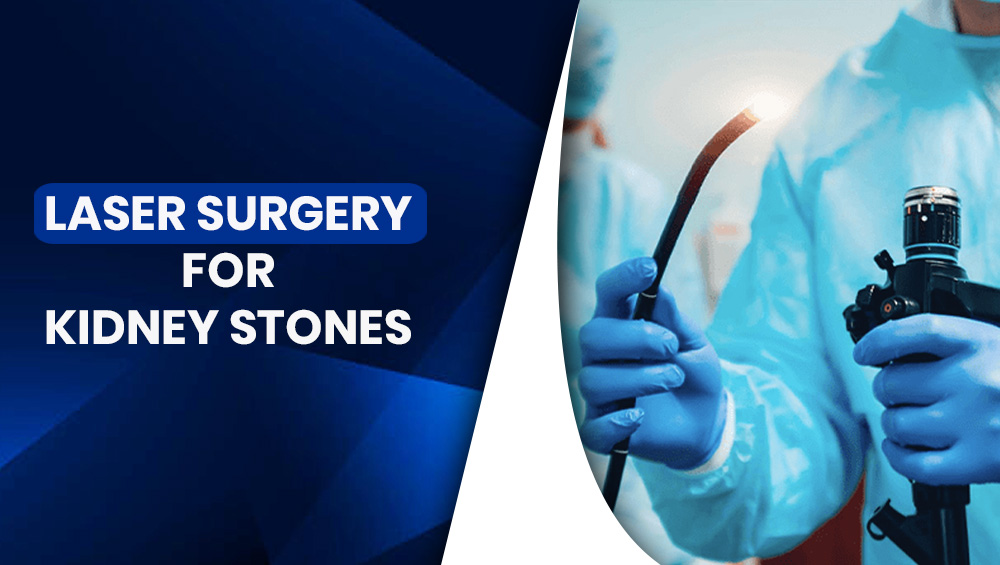Kidney stones are not only painful but can significantly disrupt your daily life. The sharp, sudden pain, difficulty in passing urine, and constant discomfort make finding an effective treatment a priority for anyone dealing with this condition. Thankfully, advancements in medical technology have introduced laser surgery—a modern, minimally invasive solution that effectively tackles kidney stones with precision and ease.
Laser surgery for kidney stones, often referred to as laser lithotripsy, uses highly concentrated laser energy to break down stones into tiny fragments, which can then be passed naturally or removed during the procedure. This method has gained popularity due to its high success rate, reduced risk of complications, and faster recovery time compared to traditional surgical options.
In this blog, we’ll delve deeper into how laser surgery works, the advantages it offers over other treatments, and who might be the ideal candidate for this procedure.
What is Laser Surgery for Kidney Stones?
Laser surgery for kidney stones, medically known as laser lithotripsy, is a minimally invasive procedure used to break down kidney stones into smaller, passable fragments. It is often performed when kidney stones are too large to pass naturally or when they cause severe pain, infection, or blockages in the urinary tract.
During the procedure, a thin, flexible tube called a ureteroscope is inserted through the urethra and bladder to reach the stone. Once the stone is located, a high-powered laser beam is used to fragment the stone into tiny particles. These fragments can then pass naturally through urine or be removed during the procedure.
Laser surgery is considered a safe and effective treatment for kidney stones, offering several benefits, including high precision, minimal damage to surrounding tissues, a reduced risk of recurrence, and faster recovery compared to traditional surgical methods. It is commonly recommended for patients who need a quick and effective solution to alleviate symptoms and complications caused by kidney stones.
How Many Types of Laser Surgeries for Kidney Stones Are There?
Laser surgeries for kidney stones typically fall under one main category—laser lithotripsy, but the approach can vary based on the technology used and the specific needs of the patient. Below are the common types and techniques of laser surgeries for kidney stones:
1. Holmium Laser Lithotripsy (HoLEP)
This is the most widely used laser surgery for kidney stones. The holmium laser breaks kidney stones into fine dust or fragments using pulses of laser energy. The smaller pieces are then passed naturally through urine or removed during the procedure. Holmium lasers are highly effective for stones of varying sizes and compositions.
2. Thulium Fiber Laser Lithotripsy
A newer advancement, the thulium fiber laser offers a more precise and efficient way to fragment kidney stones. It generates continuous energy, allowing better control and faster stone fragmentation. This technique is gaining popularity for its reduced operating time and increased safety.
3. Hybrid Laser Lithotripsy
This combines holmium and thulium technologies to offer tailored treatment for larger or more complex kidney stones. By using both pulse and continuous laser energy modes, hybrid techniques maximize effectiveness while minimizing damage to surrounding tissues.
4. Contact Laser Lithotripsy
This involves direct application of the laser to the kidney stone through a ureteroscope. It is particularly effective for stones in the ureters or bladder and ensures precise targeting of the stone without affecting other tissues.
5. Non-contact Laser Lithotripsy
In this method, the laser energy is applied at a short distance from the stone. It is less commonly used today but may be an option in certain cases.
Factors That Determine the Choice of Laser Surgery
The decision to opt for a specific type of laser surgery for kidney stones depends on several factors. Each case is unique, and understanding these factors helps tailor the treatment plan to ensure optimal results. Below is a detailed explanation of the key considerations:
1. Size, Location, and Composition of the Kidney Stones
- Size of the Stones:
Larger stones (above 2 cm) may require more advanced laser technologies or a combination of treatments, as breaking them into smaller fragments can take longer. Smaller stones are typically easier to manage and may require less intense laser energy. - Location of the Stones:
Stones located in different parts of the urinary tract, such as the kidney, ureter, or bladder, impact the choice of laser technique. For example:- Kidney stones may require flexible ureteroscopes and precise lasers to navigate delicate structures.
- Ureteral stones are often treated with direct laser application (contact lithotripsy).
- Composition of the Stones:
The type of stone (calcium oxalate, uric acid, struvite, or cystine) affects how easily it can be fragmented. Harder stones, such as those composed of calcium oxalate, may require higher energy or continuous lasers like thulium fiber lasers, while softer stones may respond to pulsed laser energy.
2. The Patient’s Overall Health and Anatomy
- Health Conditions:
Patients with underlying health issues, such as diabetes, obesity, or heart conditions, may need minimally invasive and shorter procedures to reduce surgical risks. Laser surgery is generally preferred for its reduced recovery time, but the approach may be modified for patients with limited tolerance for longer surgeries. - Anatomical Considerations:
The anatomy of the patient’s urinary tract plays a crucial role. Narrow ureters, congenital abnormalities, or previous surgeries can make accessing the stone more challenging. Flexible ureteroscopes with advanced laser systems are often used in such cases to navigate the complex anatomy safely. - Pregnancy or Special Situations:
For pregnant patients or those with other contraindications to general anesthesia, alternative approaches or tailored laser techniques may be considered.
3. Availability of Advanced Laser Technology at the Treatment Facility
- Type of Laser Equipment:
Advanced facilities equipped with newer technologies like thulium fiber lasers or hybrid lasers offer more precise and efficient treatment options. These technologies can significantly reduce operating time and patient discomfort. However, not all centers may have access to such tools. - Surgeon Expertise:
The availability of skilled urologists familiar with specific laser systems is equally important. Expertise in handling advanced laser equipment ensures a safer and more effective procedure. - Hospital Resources:
Hospitals with a well-equipped endourology unit can handle complex cases better, offering patients access to multiple treatment modalities and post-operative care.
Why These Factors Matter
Each patient’s kidney stone condition is unique, and the choice of laser surgery depends on a combination of these factors. A customized approach ensures:
- Higher success rates
- Reduced risk of complications
- Faster recovery time
Laser surgeries are highly effective and minimally invasive, making them the preferred option for most patients with kidney stones. However, consulting with a urologist will help determine the most suitable approach for each individual.
Expert Urological Care With Dr. Deepanshu Gupta
Dr. Deepanshu Gupta stands as one of the best urologists in Gurgaon, renowned for his expertise in diagnosing and treating a wide range of urological conditions with precision and care. With advanced training and a compassionate approach, he combines state-of-the-art technology with personalized treatment plans to ensure optimal outcomes for his patients.
Be it addressing kidney stones, prostate issues, or complex urological surgeries, Dr. Gupta’s dedication and skill make him a trusted name in the field. For anyone seeking expert urological care in Gurgaon, Dr. Deepanshu Gupta offers unparalleled medical excellence and patient satisfaction.

